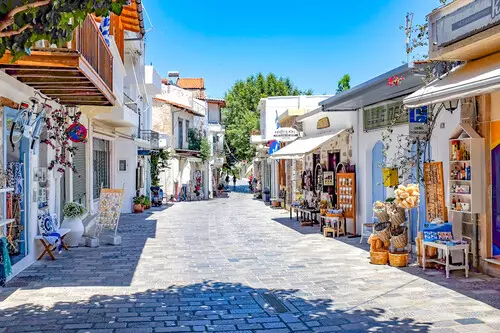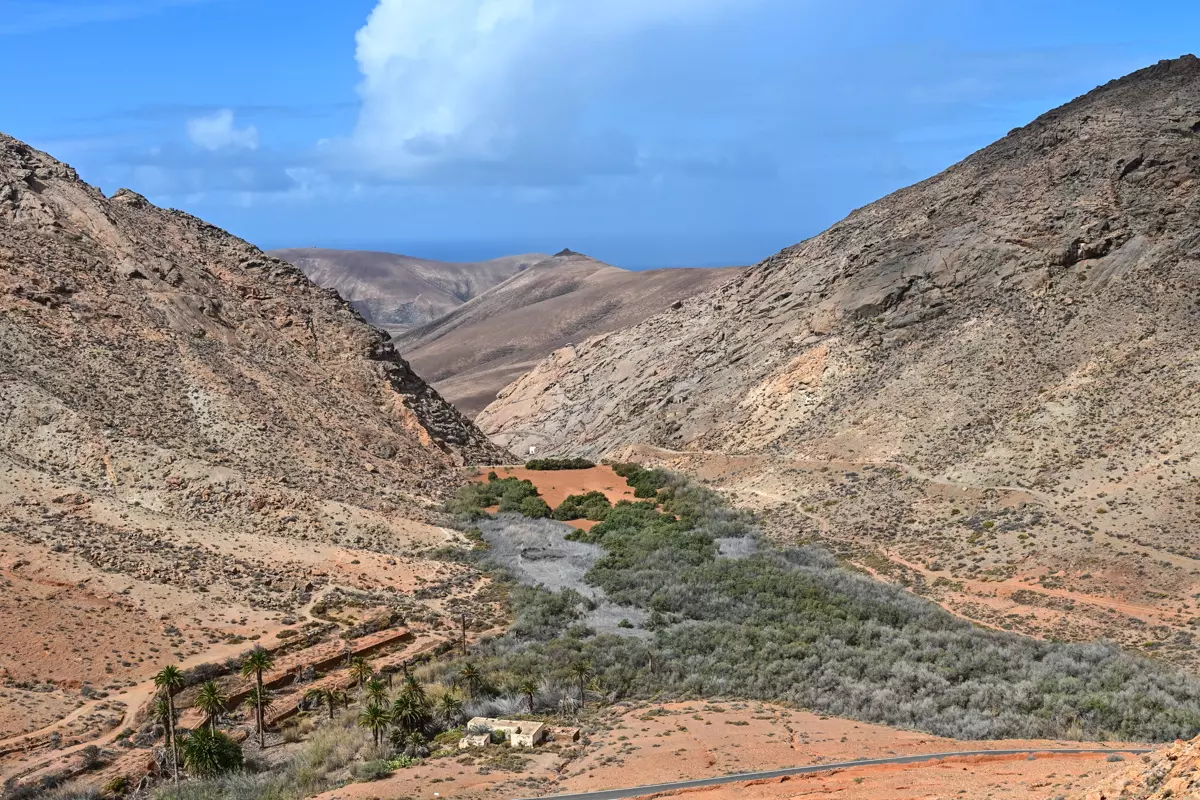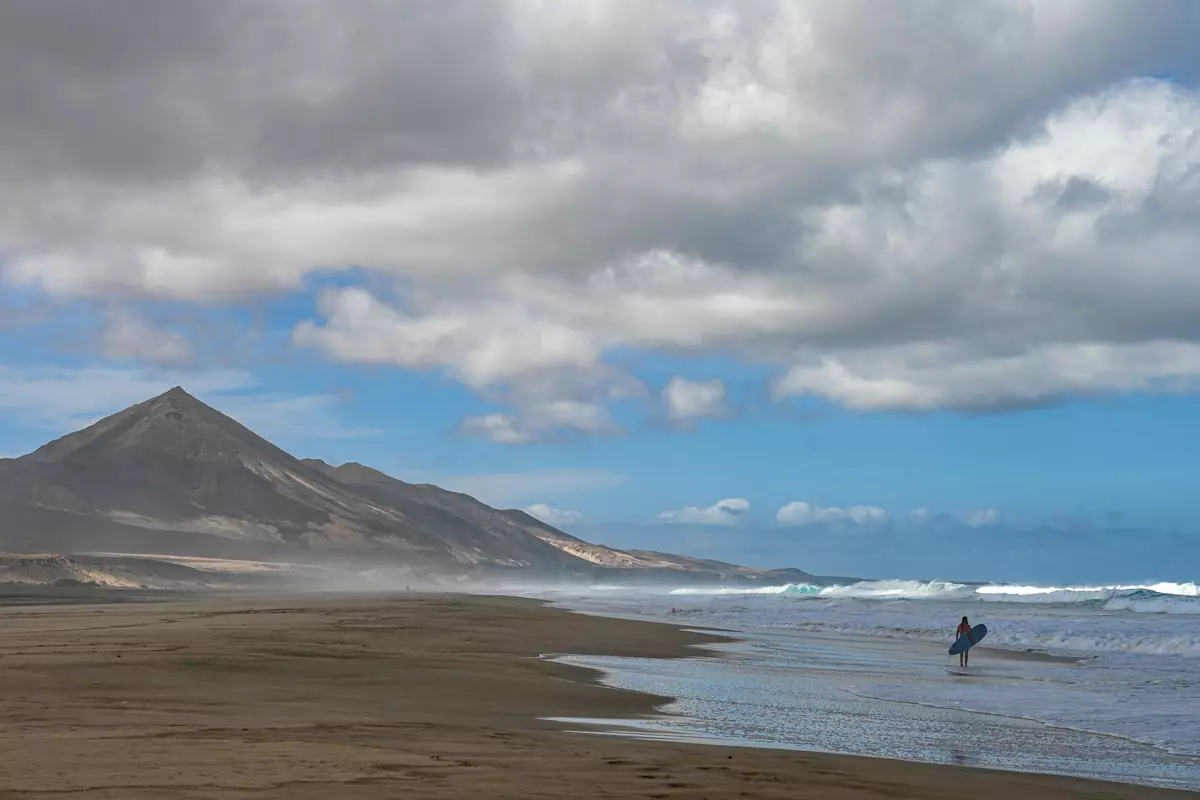Best Beaches In Fuerteventura To Explore
Fuerteventura is one of the Canary Islands, enticing travelers with its wild nature, year-round warmth, and, of course, breathtaking beaches. I’ve visited almost all of the Canary Islands, but the wild Fuerteventura is the one closest to my heart. I’ve been there twice already, and if the opportunity comes, I’ll definitely return. While exploring the island, I researched the best beaches in Fuerteventura and decided to create a detailed guide to share them with you.
In this guide, you will find everything from map-marked locations to tips on where to stay, how to get around the island comfortably, and how to stay connected (yes, we are talking about eSIMs). Are you ready to go? Let’s begin a sun-soaked journey along the shores of Fuerteventura—together.
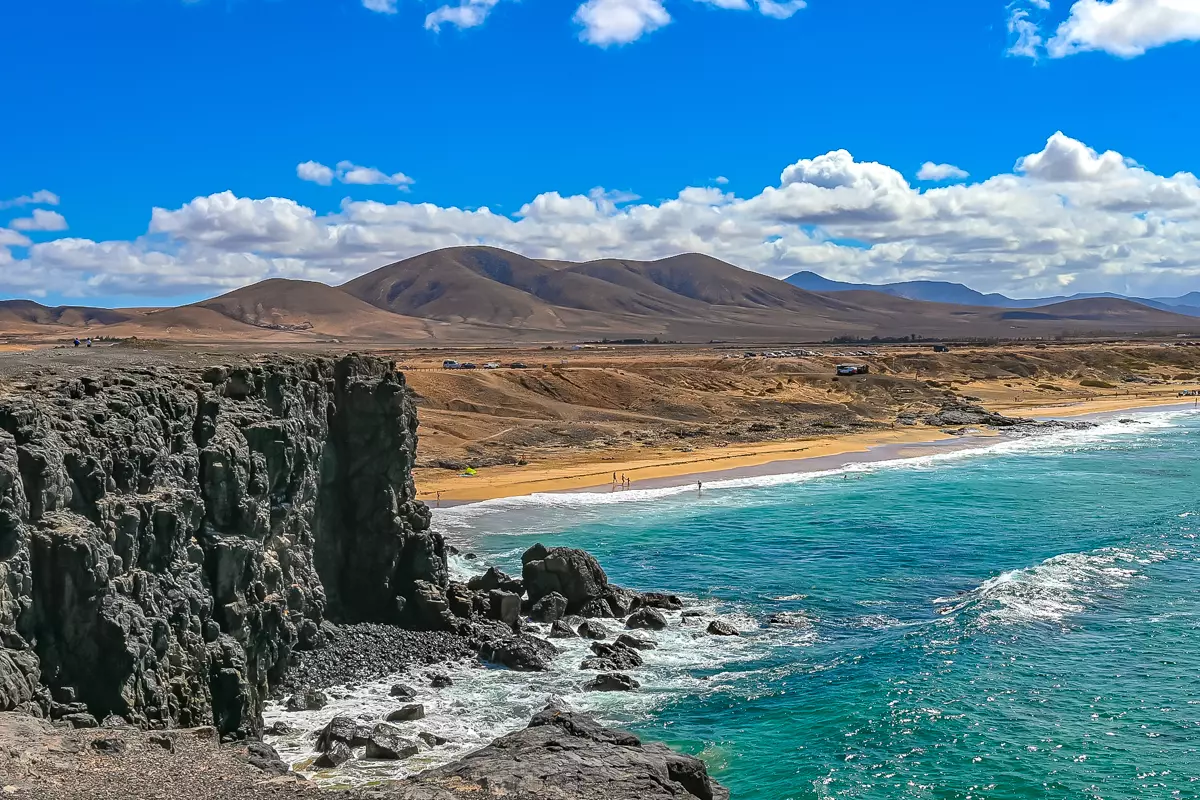
Fuerteventura’s Beach Regions
To better understand where the most beautiful beaches of Fuerteventura are hidden, it’s helpful to look at the island by region. While the island isn’t very large, each coastline offers a completely different experience—from peaceful oases to surfers’ paradises.
North – Bohemian Vibes and a Surfer’s Paradise
The area around Corralejo and El Cotillo. Here you can discover fine white sand beaches, nearby sand dunes, and rugged coastlines.
Best for: active travelers, surfers, and those looking for a laid-back, hippie-style atmosphere.
South – Longest Sandy Stretches and Holiday Calm
The area around Morro Jable and Costa Calma. This is where the island’s longest beaches are found, with plenty of hotels nearby.
Best for: families, couples, and those seeking comfort.
West – Wild Nature and Dramatic Shores
Less developed in terms of tourism, but the natural scenery is truly breathtaking.
Best for: those who want to escape the crowds and explore wild, untouched beaches.
East – Local Life and Smaller Beaches
The beaches on this side are cozy, with local cafes nearby. You will also find traditional villages here, making it a great choice for travelers looking for quality relaxation and valuing authenticity.
Discover: Jandia Natural Park & Cofete Beach Jeep Tour.
Top Beaches In Fuerteventura
Now that you have a sense of how the island is divided, let’s explore Fuerteventura’s most stunning beaches one by one. Each has its own rhythm, charm, and reasons to fall in love.
Playa de Cofete
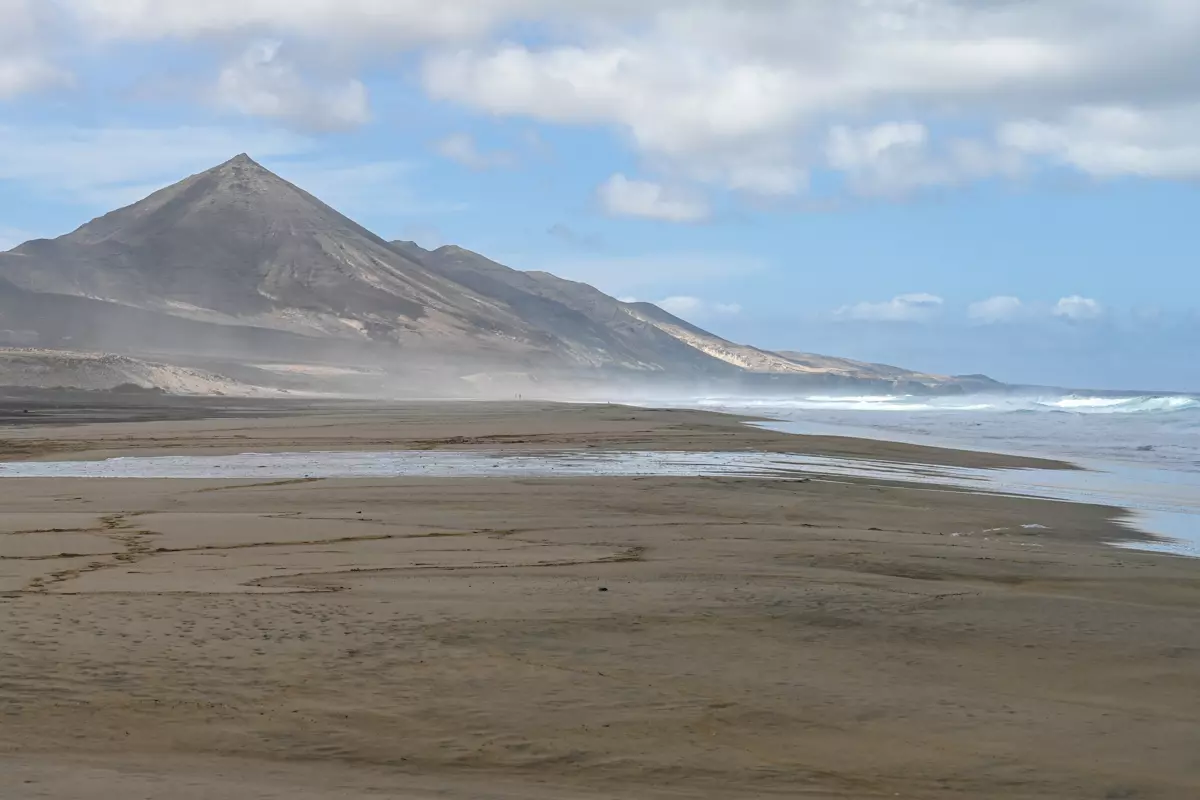
Playa de Cofete is, without a doubt, the most impressive beach in Fuerteventura for me. It’s located on the southwestern coast, in the Jandia Peninsula. Getting there isn’t easy. The road to the beach is bumpy, but it’s absolutely worth it.
As you descend the winding road from the mountains, a vast coastline will unfold before you, where you’ll be greeted by wind, sand, and the ocean. You won’t find any bars or sunbeds here—just the pure beauty of the landscape. Curious to see more? Take a walk to Villa Winter, a mysterious villa surrounded by various legends.
Tip: Due to strong currents, I don’t recommend swimming here. Instead, take your time to enjoy a peaceful walk or capture the moment with a photo session.
Playa de Sotovento
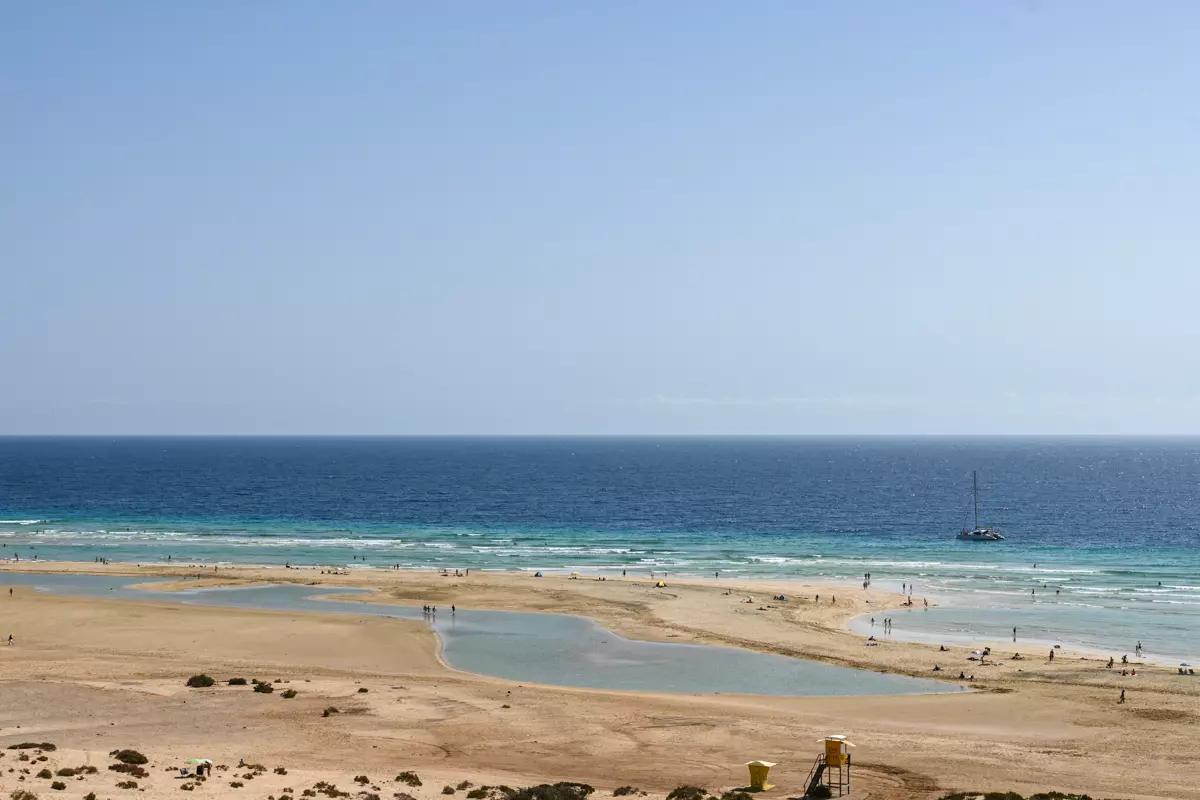
Playa de Sotavento is one of the most beautiful beaches in Fuerteventura, stretching along the southeastern coast near Costa Calma. Here you will be greeted by long stretches of sand, shallow lagoon waters, and steady wind. It is an ideal place for kite and windsurfing enthusiasts.
When the tide comes in, the sand turns into a shallow lagoon. It’s anan ideal spot for safe swimming. And when the tide goes out, an impressive sandy expanse appears, where it’s easy to find a quiet place all to yourself. Sotavento changes with the rhythm of nature, making every visit unique.
Tip: Check the tide times—if you want to catch the lagoon at its most beautiful, it’s worth planning ahead.
Also read: Sotavento Beach Full Guide
Playa del Matorral
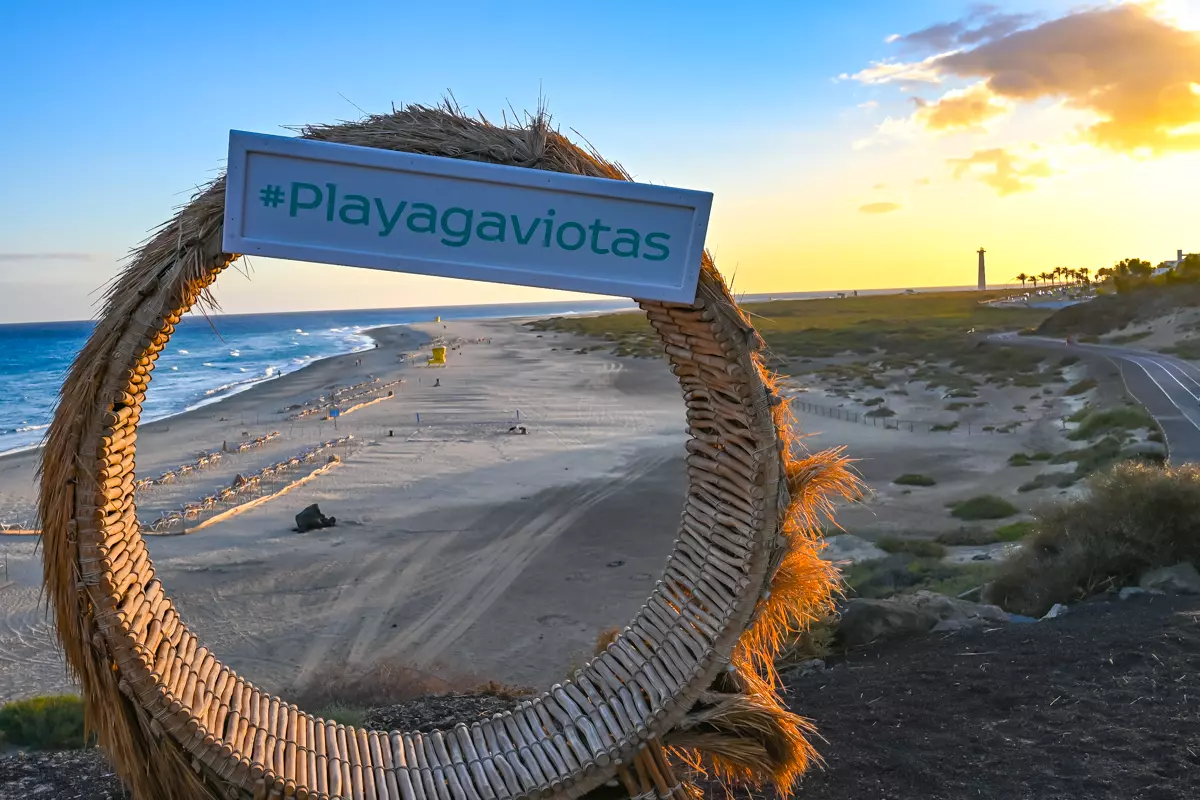
Located in the southern part of the island, near the resort town of Morro Jable, Playa del Matorral is one of the most accessible beaches in Fuerteventura. Here you will find a wide stretch of sand gently sloping into crystal-clear water, calm waves, and full resort infrastructure just a few steps away.
It is a perfect place for those seeking comfort. Nearby you will find restaurants, shops, bars, and beach services. Enjoy walking? A seaside path runs alongside the Faro de Morro Jable lighthouse, which marks the transition from natural landscape to resort area. Locals also frequent this beach — both to relax and to stay active.
Tip: If you’re looking for a quieter experience, head to the nearby Playa Gaviotas. I stayed at the Iberostar Waves Gaviotas Park resort and really liked how close the beach was—just a few steps away.
Discover: Glass Bottom Boat Cruise with Lunch & Drinks.
Playa de Esquinzo
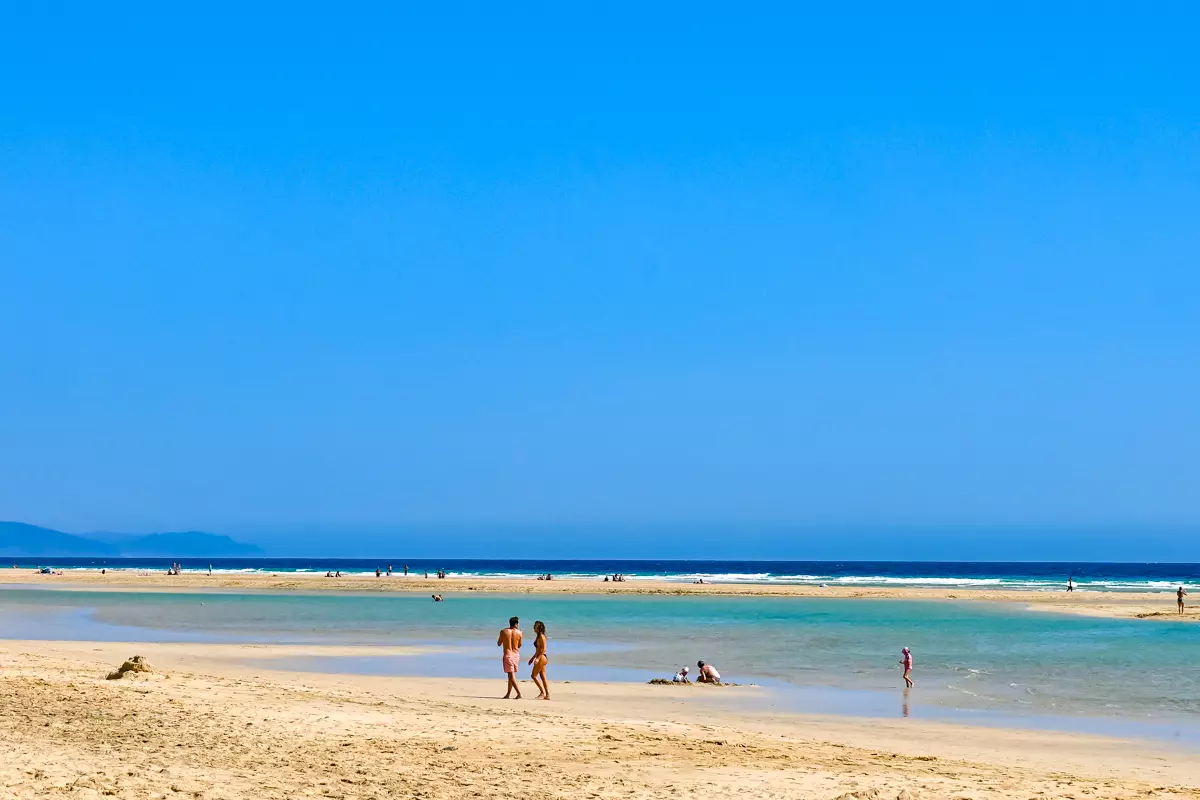
If you are looking to escape the hustle and bustle of resort life, choose Playa de Esquinzo. Located between Costa Calma and Morro Jable, this beach is often overlooked by tourists, which means you will find more peace, space, and nature here.
A wide stretch of sand, gentle waves, and surrounding cliffs create a calm atmosphere. It’s perfect for couples, solo travelers, or anyone simply wanting a quiet place to relax. Although the beach is not completely wild, services are limited, so don’t forget to bring water and snacks with you.
Discover: Magic Catamaran Trip with Food and Drinks.
El Cotillo & Nearby Beaches
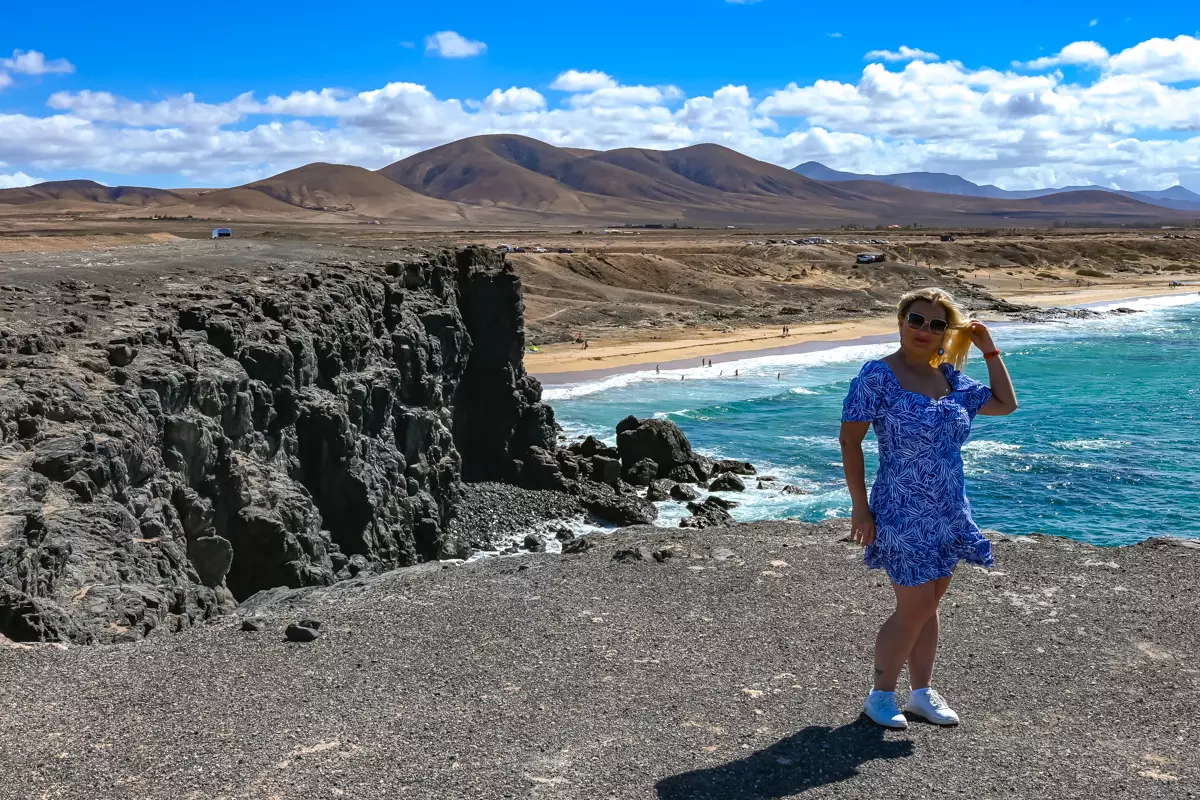
Located in the northwest, El Cotillo is a small coastal town surrounded by a mosaic of peaceful lagoons and wild beaches. The most visited among them is Playa de La Concha. It’s a curved, white-sand beach protected by natural lava rock formations. Calm waters, barely noticeable waves, and a shallow lagoon make it a true paradise for families, couples, and anyone looking for a peaceful swim.
A bit farther from the main beach, the shoreline becomes more open and natural—ideal for long walks or quiet moments alone. You will often see locals here, stretched out on the sand with a book or surfers catching waves. The beach that impressed me the most was Playa del Castillo. I completely lost track of time, and a few hours passed by in what felt like a moment.
Tip: Arrive at Playa de La Concha early in the morning. The beaches are still empty, and the water is calm. If you are looking for a quieter atmosphere, I suggest choosing one of the smaller lagoons.
Playa del Castillo

Just 10 minutes from Fuerteventura Airport, in the town of Caleta de Fuste, you’ll find Playa del Castillo. This spot attracts visitors with its shallow shoreline, gentle waves, and family-friendly infrastructure.
Although the beach is man-made, it blends harmoniously into the surroundings. The enclosed bay ensures safe swimming even for the youngest visitors, while the nearby promenades invite you to take a stroll, sip coffee, or spend a quiet evening overlooking the marina.
Good To Know: This is one of the best beaches for those who prefer not to rent a car. Everything is easily accessible on foot, and the beach is just a short walk from most hotels.
Popcorn Beach
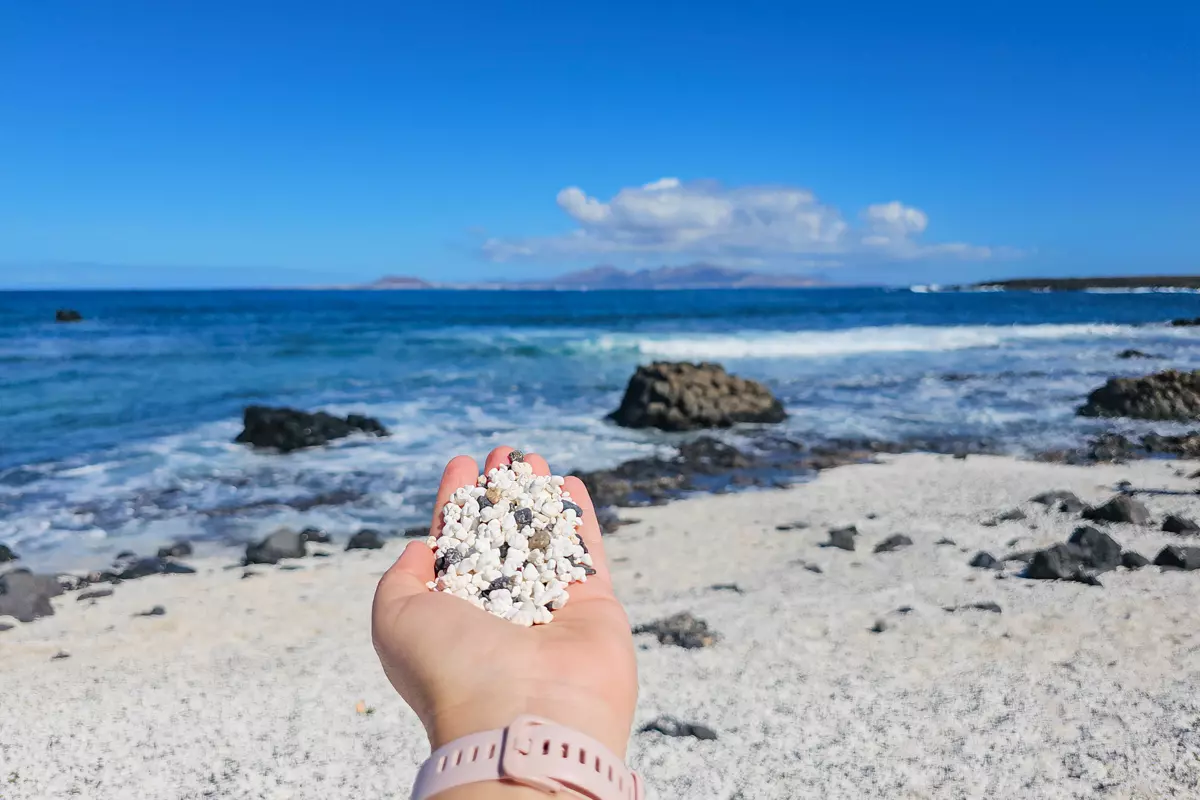
If you’ve ever dreamed of walking on sand that looks like popcorn, Popcorn Beach is exactly that kind of place. Located on the northern coast near the town of Corralejo, this beach this beach is officially known as Playa del Bajo de la Burra. It’s not popular for swimming or sunbathing, but for its incredible natural oddity.
The beach is covered in white fossilized algae that resemble popcorn, which is how it got its unexpected name. While it’s not a spot for a classic beach holiday (the area is windy, the shoreline is rough, and there’s no fine sand), Instagram lovers, travelers, and children will be fascinated.
Tip: Don’t take any popcorn with you. It’s a protected part of the natural landscape. Locals kindly ask visitors to respect this unique environment and leave it as they found it.
Playa de Ajuy
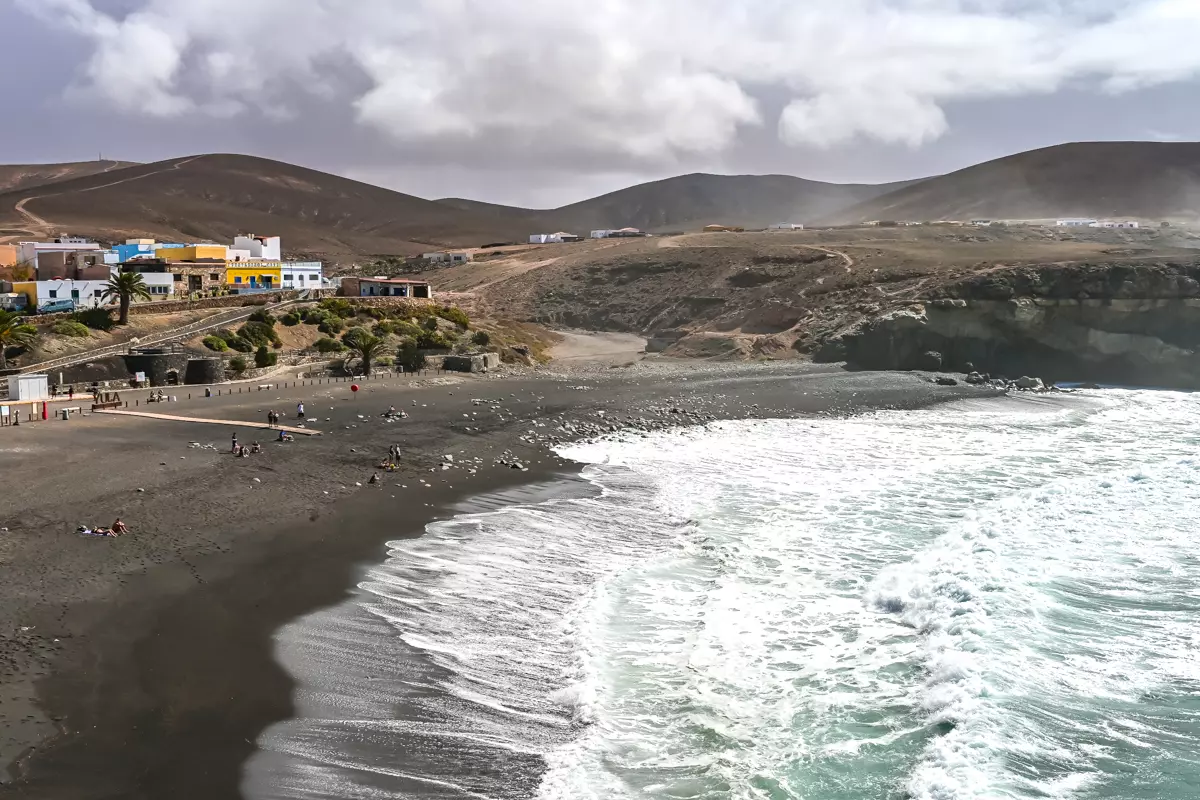
Looking to experience a different side of Fuerteventura? Head to the island’s west coast, to the small fishing village of Ajuy, where you will be greeted by a dramatic shoreline, black sand, and caves hiding millions of years of geological history. Playa de Ajuy, located next to the famous Ajuy Caves, is not meant for typical beach swimming, but what happens here is hard to put into words.
Strong winds, powerful waves, and the contrast between the black sand and white surf create a breathtaking landscape. The beach is surrounded by high cliffs, and in the distance, you’ll see the trail leading to the caves. It’s a path into geological history dating back more than 70 million years.
Tip: Visit in the late afternoon. At that time, the light on the cliffs and waves creates an incredible view. Be sure to wear comfortable shoes if you plan to walk to the caves. The path is rocky but not difficult.
Also read: Ajuy Caves (Full Travel Guide)
Playa del Viejo Rey
On the western coast, near the town of La Pared, stretches Playa del Viejo Rey. This is one of the most popular spots among surfers and is perfect for those who want to experience the raw power of nature—wind, waves, cliffs, and a sense of freedom.
The coastline here is very windy, so swimming requires caution, but walking, photo sessions, and surf watching are truly unforgettable. The beach is wide, wild, and often almost empty. There are just a few people on the horizon. It feels like stepping into another world.
Tip: Bring water, a sun hat, and some snacks. There are no services on-site, but you will find a few nearby surfer cafes with a laid-back vibe.
Where To Stay Near The Beaches
Looking for a place to stay close to the sand, the wind, and the ocean? Fuerteventura’s different regions each offer unique experiences to match your vacation style—whether you want to stay active, relax with your family, or escape the crowds. In this section, I provide a practical breakdown of the different areas.
North – Corralejo & El Cotillo
The northern coast pulses with energy, wind, creativity, and surf culture. Corralejo offers more action: bars, restaurants, nightlife, and adventure activities. El Cotillo is the opposite—quiet, slow-paced, and bohemian, perfect for switching off and chasing sunsets.
Ideal for: surfers, couples, lovers of a laid-back vibe
Nearby beaches: Popcorn Beach, El Cotillo beaches
Where to stay:
- Corralejo – a town with full tourist infrastructure, surf schools, and a lively atmosphere
- El Cotillo – a peaceful fishing village with white-sand lagoons and local charm
South – Morro Jable, Costa Calma, Esquinzo, Las Gaviotas
The southern region of Fuerteventura offers comfort, space, and the perfect balance between tranquility and accessibility. You’ll find long beaches, easy access, and well-developed infrastructure that make it ideal for a stress-free holiday. On both of my trips to Fuerteventura, I chose to stay in the south. With a rental car, reaching the island’s top beaches was easy.
Ideal for: families, couples, those seeking a relaxing and comfortable stay
Nearby beaches: Playa de Cofete, Playa del Matorral, Playa de Esquinzo, Playa de Sotavento
Where to stay:
- Morro Jable – a convenient town with plenty of accommodation options, restaurants, and excursions
- Costa Calma – great for those interested in sports, especially kiteboarding; peaceful but active
- Las Gaviotas & Esquinzo – a more resort-style vibe, with hotels close to the sea, ideal for those looking for comfort
Accommodation: Explore all your hotel options in Fuerteventura here.
West – Ajuy, La Pared
The west coast is wild, dramatic, and largely untouched by tourism. Expect black-sand beaches, impressive cliffs, and the full force of nature through waves and wind.
Ideal for: nature lovers, spontaneous travelers
Nearby beaches: Ajuy Beach, Playa del Viejo Rey, Playa de Cofete
Where to stay:
- La Pared – a small surfer-friendly town with a wild coastline and authentic vibe
- Ajuy – accommodation options are limited, so it’s better to stay in nearby towns like Pajara or Betancuria
East – Caleta de Fuste
The eastern side of the island is the easiest to access and best suited for “relax and do nothing” holidays. If you don’t want to rent a car and prefer to have everything within walking distance, this is the best choice.
Ideal for: families, first-time visitors, carefree travel
Nearby beaches: Caleta de Fuste
Where to stay:
- Caleta de Fuste – closest to the airport, with a wide range of hotels and family-friendly infrastructure
Accommodation: Ready to stay near Fuerteventura’s best beaches? Discover handpicked hotel options here.
How To Get Around Fuerteventura
To visit not only the popular but also the more secluded beaches, it’s important to plan in advance how you’ll get around Fuerteventura. While the island isn’t very large, different modes of transport offer very different possibilities.
Car Rental
If you want to reach more remote beaches such as Playa de Cofete or Viejo Rey, having a car is practically essential. The roads on the island are in good condition, traffic is light, and parking is free almost everywhere.
Tip: Book your car online in advance for a wider selection. If you’re planning to visit Fuerteventura’s best wild beaches, it’s better to go for a 4×4 vehicle.
Public Transport
Fuerteventura has a public bus system called Tiadhe, but the routes do not provide access to the island’s most remote beaches. However, if you’re staying in Costa Calma, Caleta de Fuste, or Corralejo and only plan to visit nearby beaches, the bus should be sufficient.
Good To Know: Buses run less frequently on weekends and in the evenings. Tickets can be purchased from the driver (in cash or by card).
Staying Connected In Fuerteventura
Wherever you are—whether in town or by the ocean—mobile coverage in Fuerteventura is reliable. However, to avoid expensive roaming charges, it’s worth getting an eSIM or a local SIM card. It’s a good idea to plan your connectivity in advance—especially if you’ll be using maps, uploading content, or working remotely.
Best Options For Internet Access
Holafly – This is one of the easiest and most convenient solutions. You can activate your eSIM even before leaving home, and it will start working the moment you land in Fuerteventura. No need to search for local shops or swap physical cards.
Local SIM card (Movistar, Orange, Vodafone) – If you prefer a traditional SIM card, you can buy one at the airport or in major towns. These operators offer good coverage across the island, including in more remote areas.
Tip: Choose a larger data plan with hotspot capabilities when you plan to work or stay for extended periods on the island, because remote areas require this feature.
FAQ About Fuerteventura’s Beaches
Yes, all beaches on the island are public and free to access. You can visit any of them freely, regardless of whether there’s a hotel nearby or not.
Not necessarily. Most beaches can be reached with a regular car, but places like Playa de Cofete and a few others are best accessed with a 4×4.
Yes. I recommend using services like Holafly—they work reliably across the island, even in remote areas.
Fuerteventura is a very safe destination for travelers, and even remote beaches are generally secure. However, as always, keep an eye on your belongings—especially if you leave them in the car.
In most of them, yes. However, the west coast (e.g., Cofete, Viejo Rey) can have strong currents and waves, so be cautious. Look for lifeguard flags or simply observe what the locals do.
If you plan to travel around the island for 7–10 days and have a car, it’s definitely possible to visit Fuerteventura’s best beaches. But if you prefer a slower pace, it’s better to choose one or two regions and explore them more deeply.
Book your flight
For the best flight deals, I always rely on Skyscanner. Features like Multi-city and Explore Everywhere help me uncover incredible travel opportunities.
Rent a car
Discovercars is my top choice for comparing car rental prices for any road trip around the world. The booking experience is always smooth and easy.
Travel insurance
SafetyWing provides affordable travel medical insurance with global coverage, perfect for digital nomads and long-term travelers.
Book Tours & Attractions
Experiencing a destination to the fullest is easier with a well-planned itinerary. I use GetYourGuide for guided tours and Tiqets for quick access to museum and amusement park tickets.
Protect yourself online by VPN
No matter where I go, I always use NordVPN for secure browsing and to ensure I can access websites that might be blocked in certain countries.
Disclosure: I only suggest companies that I personally rely on. If you use the affiliate links in my posts to book services, I’ll earn a small commission, with no extra cost to you.
Here are the best beaches in Fuerteventura! Which ones would you visit? Share in the comments!
Share on

Hi, I’m Evelina, a travel enthusiast who loves nature, peace, and authentic places. I cherish the freedom to explore and learn with each adventure, whether it’s hiking trails, stunning beaches, natural parks, unique architecture, or rich cultural heritage. I hope my experiences inspire you to embark on your own journeys!
